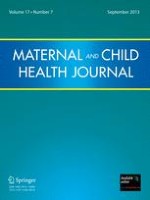01-09-2013
Least Explored Factors Associated with Prenatal Smoking
Published in: Maternal and Child Health Journal | Issue 7/2013
Login to get accessAbstract
Poor pregnancy and birth outcomes are major problems in the United States, and maternal smoking during pregnancy has been identified as one of the most preventable risk factors associated with these outcomes. This study examines less explored risk factors of smoking among underserved African American pregnant women. A cross-sectional survey was conducted at an outpatient obstetrics-gynecology clinic of an inner-city university hospital in Virginia from March 2009 through January 2011 in which pregnant women (N = 902) were interviewed at their first prenatal care visit. Survey questions included items related to women’s sociodemographic characteristics as well as their pregnancy history; criminal history; receipt of social services; child protective services involvement; insurance status; and history of substance abuse, domestic violence, and depression. Multiple logistic regression was conducted to calculate odds ratios and 95 % confidence intervals depicting the relationship between these factors and smoking during pregnancy. The analysis reported that maternal age [OR = 1.08, 95 % CI = 1.05–1.12], less than high school education [OR = 4.30, 95 % CI = 2.27–8.14], unemployed [OR = 2.33, 95 % CI = 1.35–4.04], criminal history [OR = 1.66, 95 % CI = 1.05–2.63], receipt of social services [OR = 2.26, 95 % CI = 1.35–3.79] alcohol use [OR = 2.73, 95 % CI = 1.65–4.51] and illicit drug use [OR = 1.97, 95 % CI = 1.04–3.74] during pregnancy were statistically significant risk factors associated with smoking during pregnancy. In addition to the well known risk factors, public health professionals should be aware that criminal history and receipt of social services are important factors associated with smoking during pregnancy. Social service providers such as WIC and prisons and jails may offer a unique opportunity for education and cessation interventions during the preconception or interconception period.





